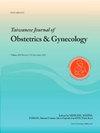Clinical and sonographic risk factors for developing pre-eclampsia refractory to aspirin prophylaxis
IF 2
4区 医学
Q2 OBSTETRICS & GYNECOLOGY
引用次数: 0
Abstract
Objective
Identify risk factors for development of preeclampsia refractory to aspirin prophylaxis in women at high-risk of preeclampsia.
Material and methods
A retrospective cohort study analyzed 206 women identified as high-risk for preeclampsia through first-trimester screening and prescribed aspirin prophylaxis. We compared maternal characteristics, medical history, biochemical markers, and uterine artery Doppler indices between those with and without preeclampsia.
Results
Women with preeclampsia had significantly higher rates of chronic hypertension (54.3% vs. 8.2%), higher first-trimester mean arterial pressure (MAP, 109.6 vs. 95.4 mmHg), and higher body mass index (BMI, 27.6 vs. 24.9) compared to controls. Second-trimester MAP and mean uterine artery pulsatility index (UtA-PI) were also significantly elevated in the preeclampsia group (103.3 mmHg and 1.39, respectively) compared to controls (89.7 mmHg and 1.05). ROC curve analysis identified an optimal second trimester UtA-PI cut-off of 1.36 for predicting preeclampsia, with sensitivity of 49% and specificity of 87.1%. When using a cut-off value of 0.77 for the second-to-first trimester UtA-PI ratio, the sensitivity and specificity were 60% and 90.6%, respectively.
Conclusion
Chronic hypertension, high first and second trimester MAP, higher BMI, and elevated second trimester UtA-PI are associated with preeclampsia despite aspirin prophylaxis. Evaluating second trimester UtA-PI or the ratio of second to first trimester UtA-PI may be a promising tool for identifying women who do not respond to aspirin.
阿司匹林预防难治性先兆子痫的临床和超声风险因素
材料与方法回顾性队列研究分析了 206 名通过产前筛查被确定为子痫前期高危并服用阿司匹林预防的妇女。结果与对照组相比,子痫前期妇女的慢性高血压发病率明显更高(54.3% 对 8.2%),第一胎平均动脉压(MAP,109.6 对 95.4 mmHg)更高,体重指数(BMI,27.6 对 24.9)也更高。与对照组(89.7 mmHg 和 1.05)相比,子痫前期组的第二胎 MAP 和平均子宫动脉搏动指数(UtA-PI)也明显升高(分别为 103.3 mmHg 和 1.39)。ROC曲线分析确定了预测子痫前期的最佳第二孕期UtA-PI临界值为1.36,灵敏度为49%,特异性为87.1%。结论 尽管服用了阿司匹林预防措施,但慢性高血压、前三个月和后三个月高 MAP、较高的体重指数和后三个月升高的 UtA-PI 与子痫前期相关。评估第二孕期UtA-PI或第二孕期UtA-PI与第一孕期UtA-PI的比值可能是识别对阿司匹林无反应的妇女的有效工具。
本文章由计算机程序翻译,如有差异,请以英文原文为准。
求助全文
约1分钟内获得全文
求助全文
来源期刊

Taiwanese Journal of Obstetrics & Gynecology
OBSTETRICS & GYNECOLOGY-
CiteScore
3.60
自引率
23.80%
发文量
207
审稿时长
4-8 weeks
期刊介绍:
Taiwanese Journal of Obstetrics and Gynecology is a peer-reviewed journal and open access publishing editorials, reviews, original articles, short communications, case reports, research letters, correspondence and letters to the editor in the field of obstetrics and gynecology.
The aims of the journal are to:
1.Publish cutting-edge, innovative and topical research that addresses screening, diagnosis, management and care in women''s health
2.Deliver evidence-based information
3.Promote the sharing of clinical experience
4.Address women-related health promotion
The journal provides comprehensive coverage of topics in obstetrics & gynecology and women''s health including maternal-fetal medicine, reproductive endocrinology/infertility, and gynecologic oncology. Taiwan Association of Obstetrics and Gynecology.
 求助内容:
求助内容: 应助结果提醒方式:
应助结果提醒方式:


